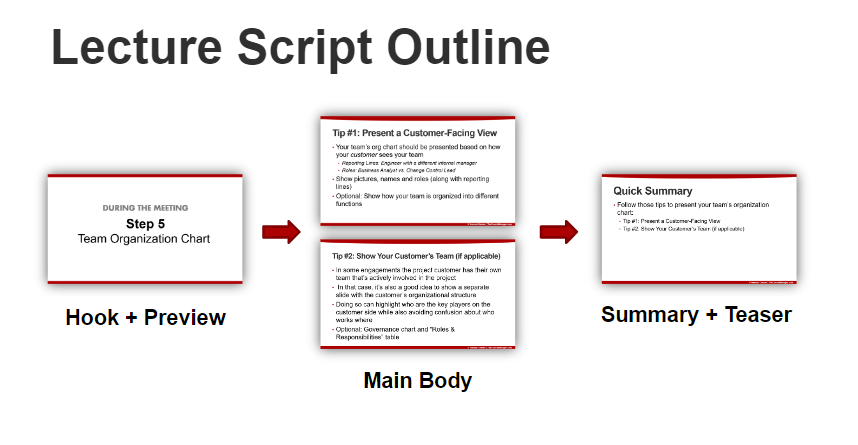
Creating compelling and engaging Udemy lecture scripts help keep your students coming back for more. In this post, we’ll walk through the step-by-step process of how to outline your Udemy lecture scripts effectively.
The Three-Part Structure
Before we dive into the details of outlining your lecture script, let’s start by understanding the three-part structure that forms the backbone of a successful Udemy lecture. This structure consists of:
1. The Hook and Preview
The hook and preview are your way of capturing your students’ interest and encouraging them to watch your lecture. Here’s how it works:
- Hook: Begin your lecture with a captivating hook. This can be a thought-provoking question, a surprising fact, or a relatable story. The key is to pique your audience’s curiosity.
- Preview: After hooking your students, give them a brief preview of what they can expect to learn from the lecture. Tell them the main points you’ll cover and highlight the benefits they’ll gain from watching.
2. The Main Body
The main body is where you present your content, whether it’s steps, tips, strategies, or any other valuable information. Here’s how to structure the main body effectively:
- Organize Your Points: Make a clear outline of the points you want to cover. Whether you’re teaching a cooking technique, a programming language, or a marketing strategy, ensure that your content flows logically.
- Engage Your Audience: Use active voice and engaging language. Imagine you’re having a conversation with a friend. This helps keep your lecture relatable and easy to follow.
- Visual Aids: Incorporate visuals, such as slides or diagrams, to reinforce your points visually. Visual aids can make complex topics easier to understand.
3. The Summary and Teaser
As you end your lecture, provide a concise summary and a teaser for what’s to come. Here’s how to wrap up your lecture effectively:
- Summary: Summarize the main points you’ve covered during the lecture. This reinforces key takeaways and helps your students remember the crucial information.
- Teaser: Give your students a sneak peek into the next lecture. Teasing what they’ll learn in the upcoming lesson keeps them engaged and eager to continue with your course.
Putting It All Together
Now that we covered the three-part structure, let’s put it all together and create a compelling Udemy lecture script outline.
Step 1: Crafting the Hook and Preview
Hook: Start with a captivating hook that relates to the topic of your lecture. For example, if you’re teaching a photography course, you could begin with a question like, “Have you ever wondered how professional photographers capture those incredible shots?” This instantly grabs the viewers’ attention.
Preview: After the hook, provide a brief preview of what the lecture will cover. You might say, “In this lesson, we’ll unlock the secrets behind stunning landscape photography. You’ll discover the essential techniques used by professionals to capture breathtaking scenes.”
Step 2: Structuring the Main Body
In this section, you’ll delve into the core content of your lecture. Let’s continue with the photography course example:
Organize Your Points: Outline the key points you want to cover. These could include topics like camera settings, composition rules, and post-processing techniques. Use clear headings and subheadings to make your lecture easy to follow.
Engage Your Audience: Keep your language conversational and relatable. Avoid jargon and complex terminology unless you’ve explained it earlier in your course. Imagine you’re teaching a friend who’s new to photography.
Visual Aids: Incorporate slides with images and diagrams to illustrate your points. For instance, when explaining composition rules, show before-and-after photos to demonstrate the impact of different techniques.
Step 3: Concluding with the Summary and Teaser
Summary: As you near the end of your lecture, recap the main takeaways. For a photography lecture, you could say, “To recap, we’ve just explored the importance of composition, mastered key camera settings, and learned post-processing tips. These skills are the foundation of stunning landscape photography.”
Teaser: Create excitement for the next lecture. Give your students a glimpse of what they’ll learn in the following lesson. For example, “In our next session, we’ll delve into the art of capturing golden hour moments. You’ll discover how lighting can transform your photos and create magical landscapes.”
Why Outlining Matters

Here are a few reasons why it’s important to follow an outline when designing your lectures:
1. Clarity and Organization
An outline ensures your lecture flows logically. It helps you organize your thoughts and prevents you from veering off track. When students can follow your content seamlessly, they’re more likely to stay engaged.
2. Engagement and Retention
A well-structured lecture script keeps your students engaged throughout the course. The hook captures their attention, the main body delivers valuable content, and the summary reinforces key points. This engagement leads to better retention of the material.
3. Professionalism
Following a structured outline gives your lectures a professional and polished feel. It shows that you’ve put thought and effort into delivering high-quality content, which enhances your credibility as an instructor.
4. Marketing Your Course
Remember, even after students have enrolled in your course, it’s essential to market it continuously so that they keep watching. The hook and teaser at the beginning and end of each lecture remind students of the value they’re receiving. This can encourage them to continue watching and even recommend your course to others.
Conclusion
Creating captivating Udemy lecture scripts is a skill that can set you apart as an instructor. By following the three-part structure of the hook and preview, main body, and summary and teaser, you’ll keep your students engaged, informed, and eager for more.
If you’d like to learn more, check out “Create & Sell an Online Course on the Side” to learn how to publish bestselling courses on Udemy